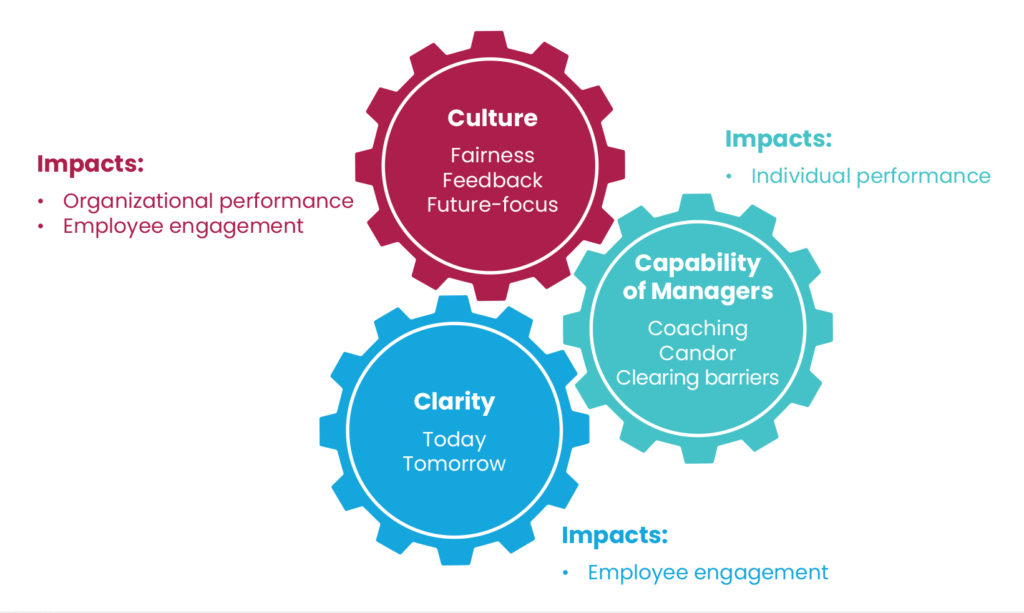Modern Performance Mgmt: Lessons from the Road
December 11th, 2019
After we published The Makings of Modern Performance, we then hit the road to share our findings and learn from conversations with practitioners! After 4 interactive breakfast meetings, we came away with a few lessons. In wrapping up this project, we want to share with you the things we learned.
We're losing sight of the forest
Many organizations are hyperfocused on the tactics of performance management (PM) and have lost sight of the forest (why they do it) for the trees (how they do it). Many of the questions during our time on the road focused on identifying best practices or the “right” way to do PM and were similar to those we heard during our research (see Figure 1).

Figure 1: Questions We Heard During Our Research | Source: RedThread Research, 2019.
While some organizations have taken a step back to see PM as a holistic approach to developing talent and improving performance, many organizations still struggle to shift their focus. Leaders need to focus on this question:
What should my organization do to improve the performance and engagement of our employees, and the ability of us all to meet our business goals?
The following are some of the key takeaways from our road trip.
The fairness waters are a bit muddy
In our roadshow events, there was general agreement that fairness in PM is important, and some of the new practices have helped make it more so (i.e., more frequent conversations to address recency bias, involving more people in performance feedback to reduce managers’ bias). However, we discussed how other practices, such as removing ratings or implementing shadow ratings, have increased some employees’ perceptions of unfairness.
Our research found that creating fair evaluation processes – and connecting compensation to them in a transparent and fair manner – is an important part of performance management. In our (well-intended) efforts to address important concerns about ratings and evaluation methods, we might have muddied the waters. Our study gives some suggestions on how to address this issue.
A closely related topic that we also discussed was pay transparency, which our research found to be critical. Interestingly, session attendees had different levels of awareness on this topic, but one thing was certain: It doesn’t make anyone particularly comfortable.
The challenge is that pay transparency is not an all-or-nothing concept, but a continuum. At one end of the spectrum, employees have no insight into compensation philosophy, structure, and outcomes. At the other end, employees and individuals external to the organization have full access to this information and data.
Implementing pay transparency is full of “what ifs,” potential benefits, and some potentially serious drawbacks. However, employees are already having discussions about their salaries and these discussions aren’t just among colleagues in the hallway. People are more open to share the details of their compensation and benefits package to just about anyone (e.g., Glassdoor). As a result, organizations need to figure out how they will address pay transparency sooner than later.
Organizations have a choice – they can be a part of these discussions, helping to craft the narrative and using the information to better address rewards and benefits, or they can ignore it and miss this opportunity.
Engagement & performance: Increasingly intertwined
While we know that, in general, PM, engagement, learning, and career management are increasingly converging, our roadshow reinforced that the first 2 have grown particularly close. Performance practices, when done well, can engage employees by providing them with a culture in which they can thrive and with the clarity they need to perform well today and tomorrow (see Figure 2).

Figure 2: Three Levers of Performance | Source: RedThread Research, 2019.
To that end, organizations’ performance philosophies and practices need to be designed and executed to engage employees, in addition to helping them perform better. In the future, this likely means that organizations need a more nuanced and personalized understanding of what engages employees, and to then provide them with the insights, resources, systems, and metrics that are most relevant. This'll allow organizations to be more responsive to employees’ needs so they can do their best work.
PM is no longer about just measuring performance. It's about engaging employees – in a personalized and responsive way – in their work and enabling them to perform better as a result.
Where do we go from here?
While organizational leaders can certainly make significant and important changes to their PM approaches, we think there's a bigger question that can’t be answered just by changing performance practices:
How do leaders go about creating a more responsive organization?
This question is at the heart of another project: The Responsive Organization (read: the premise, the lit review, the report, webinar and slides, and the infographic).
In this study, we're looking at the changes the leaders should make to create an environment in which people – and the organization as a whole – can be more responsive to employees and customers. For example, we think that a more responsive organization will lead to changes in the following (at a minimum):
- Communication channels – Individuals at lower levels will have data and information they need to react to needs “on the ground”
- Power structures – Decision-making will be more decentralized
- Employee development – More autonomy and continuous development will ensure that employees have the skills and knowledge they need
- Metrics – Measurements of efficiency will begin to give way to other types of productivity metrics that focus more on innovation, agility, and responsiveness
Want to share your thinking on this topic? Feel free to reach out to us at [email protected] and we will find some time to talk! Also, if you want to talk more about performance management, we would love to hear from you.